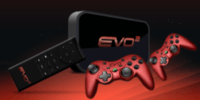EVO Smart Console
| Manufacturer | Envizions |
|---|---|
| Type | Entertainment PC |
| Release date |
October 20, 2006 (beta) November 20, 2008 (final) |
| Discontinued | 2010 |
| Units sold |
55 [1] |
| Media | DVD, CD |
| CPU |
2.9 GHz AMD Athlon (core) 800 MHz (memory). |
| Storage |
120 GB hard disk 2 GB RAM |
| Connectivity |
Ethernet 2 × USB 2.0 |
| Backward compatibility | Linux |
EVO Smart Console (originally called Evo: Phase One) is a media PC and video game console marketed in the seventh generation era, and produced by Envizions. The beta, called EVO: Phase One, was released on October 20, 2006, and the final product was released on November 20, 2008.
The system uses Linux software, which is built using the Fedora operating system. The system came bundled with three games: SuperTux, Kobo Deluxe, and Kid Destiny. The console also features high definition (HD), Internet access, and allows running Windows games. It also has a built-in 120 GB hard drive and 2 GB RAM.
Final version
The final name of the system was EVO Smart Console, and was released to developers on November 20, 2008 and it cost $250. The latest version had Amiga-based games, an Akimbo-based video on demand service. It also had a larger, 250 GB hard drive, 1080p resolution, and its own Fedora-based Linux operating system, Mirrors Evolution. There are open source codes for developers to make Linux games.
Specifications
|
|
Successors
EVO 2

The EVO 2 is a cancelled game console project first mentioned on an Envizions press release in January 9, 2011 under the name GameBox,[2] it was unveiled on May 25, 2011, with specs, images, and a new name.[3] The sources stated it was supposed to be released in fall 2011. Their website had previously stated that the console would ship in 2012.
- Specifications
- CPU: 1 GHz ARM Cortex-A8 core, Samsung S5PV210. Frequency up to 1.2 GHz,[4] 512MB memory,[4] built-in 2G memory space.
- GPU: Nvidia Tegra
- 512 MB Internal flash memory.[4][5]
- Expandable via SD/SDHC memory cards.
- SD memory card slot (supports SDHC cards)
- 5 USB 2.0 ports
- "AV Multi Out" port, supporting composite video, S-Video (NTSC consoles only)
- HDMI out port, supporting six-channel PCM linear output through HDMI
- 1080p, 1080i, 720p, 480p, or 480i, standard 4:3 and 16:9 anamorphic widescreen.
On November 28, 2012, Envizions CEO Derrick Samuels announced a new Android console, Oton, from his new startup called 'EnGeniux', effectively ending EVO 2's development.
EVO 2 DX
As of 2012, Envizions said it was developing the EVO 2 DX, a gaming PC running both Windows and Android operating systems. It was rumored to have the ability to play Android games using motion gesturing, and have a version which would play Blu-ray Discs.[6][7]
- Specifications
- CPU: An undisclosed "quad-core Opteron & Phenom" CPU
- GPU: Integrated ATI Radeon HD 4200 (DirectX 10.1)
- Chipset: AMD 785G chipset + SB750 chipset
- VGA, DVI-D, HDMI 1.3 outputs
- 4 x SATA II 3Gbit/s AMD RAIDXpert RAID 0,1,5,10
- Integrated ALC662 6-CH HD audio
- Realtek PCI-Express gigabit Ethernet
- 1 x 32-bit PCI, 1 x mini-PCI Express, 2 x eSATA
As of the cancellation of the EVO 2, it is unknown what the situation with the EVO 2 DX is.
References
- ↑ "Crowdfunding and the Mysterious Oton Console". Tap-Repeatedly. Retrieved 2012-12-30.
- ↑ Jason Rider. "An interview with Envizions founder Derrick Samuels". Thunderbolt. Retrieved 10 January 2012.
- ↑ Donald Melanson. "EVO 2 console promises to bring Android gaming to your TV". Joystiq. Retrieved 26 May 2011.
- 1 2 3 Rosenberg, Adam. "EVO 2 console will bring Android gaming to your TV". Digital Trends. Retrieved 12 September 2016.
- ↑ Piejko, Pawel. "EVO 2 gaming console to bring Android games to TV". Gizmag. Retrieved 12 September 2016.
- ↑ "EVO 2 DX". Envizionsinc.com. Retrieved 2012-11-05.
- ↑ "Envizions". Envizionsinc.com. Retrieved 2013-02-13.
External links
- Official website(Archive)